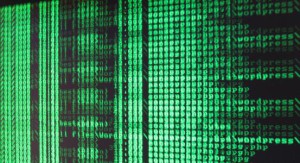 We work the blockchain together
We work the blockchain togetherMy scepticism towards Bitcoin is well-documented. While I really like the idea of decentralized payment systems and cryptocurrencies, the current implementation of Bitcoin has too many question marks for my liking. While the BTC exchange rate has been going up recently, in part prompted by a bit of hype arising from the Greek economic crisis, mainstream adoption remains elusive. Despite the almost religious fervour of some of the most enthusiastic proponents, Bitcoin remains one of those topics that interest people enough to click on a link, but not enough to get them to adopt the technology.
I suspect that Bitcoin will continue much like it is at the moment for some time, with lower transaction volumes and price fluctuation discouraging wider adoption. But there is one aspect of the Bitcoin technology that has the potential to become an outright success, and this is the blockchain.
Bitcoin is a non-fiat cryptographic decentralised payment system with no issuing authority that would serve as both a means of exchange but also as an anonymous and fully open log of all transactions (known as the blockchain). People run a client that “mines” value by verifying transactions, which encourages users to allocate processor time to confirm trades. In other words, the blockchain operates both as an open transaction ledger, and as an encouragement for people to confirm transactions by rewarding them with allocated value. This is the element of Bitcoin that has always fascinated me, and it is one of the reasons why it continues to exist despite all of the fraud accusations and crashes that have plagued the BTC economy from the start.
Whichever way you look at it, the blockchain is a fantastic idea, and thankfully it is a part of the technology that does not require Bitcoin. Because the software is completely open source, any developer can download it, modify it, and create her own version of the cryptocurrency. This capability has led to an explosion of alternative bitcoin implementations, popularly known as altcoins. There are no limits to the number of altcoins that can be released, but in practice there are a few dozen real alternatives that carry out minor or major changes, these are known as forks (my favourite altcoin remains Dogecoin).
At the moment, the main function of the blockchain in Bitcoin is to avoid the potential of double-spending money. In the real world, barring counterfeiting it is impossible to double-spend money as people hold limited amount of physical currency. But nowadays, monetary transactions often occur as the movement of value from one account to the other. The idea is for the holding institution to contain a master ledger, in other words a record of the money in all of the accounts, making it possible to follow movements from one to the other.
In Bitcoin the ledger is public and decentralised, and since anyone can check past, present and proposed transactions, there is increased reliability in the system. However, the beauty of the blockchain is that it is an idea that is independent of the existence of Bitcoin. A blockchain is quite simply any open, cryptographic, decentralised ledger, so in theory it can be implemented into any sort of scheme, financial or not, that requires a record of transactions.
There are hundreds of such potential applications in the financial markets, such as bonds, stocks, and derivatives; but it would also be possible to apply the same type of technology to automated contracts, or even copyright licensing agreements. The idea is to attempt to bypass the difficulties of contract formation and other legal transactions by allocating rights and responsibilities through electronic tokens that then would be recorded in the common ledger. A recent report explains:
“While all of the high-value applications of the first wave of blockchain innovation are explicitly financial, this is not the case for the second wave of blockchain innovation, which primarily rests on the idea of a “smart contract.” Put simply, a smart contract uses software code to implement human intentions by dynamically carrying out instructions embedded in tokens associated with a contract, rather than relying on legal texts interpreted by courts, regulatory bodies or other legal institutions.”
But this would not only apply to contracts, but also to distributing and allocating rights within decentralised organizations themselves.
There are already a number of tools that are being developed to take advantage of the blockchain beyond payment systems and cryptocurrencies. One of the most publicised has been Project Ethereum which creates “a blockchain with a built-in Turing-complete programming language, allowing anyone to write smart contracts and decentralized applications where they can create their own arbitrary rules for ownership, transaction formats and state transition functions.” In other words, Ethereum is a protocol for smart open ledgers where users can allocate their own rules and values.
Another interesting project is D-Cent, which is a European project that has proposed the creation of a social blockchain toolset that will allow adopters to generate their own alternative currency. The interesting part of this scheme is that it changes the economically-minded proof of work with a social one, which will be decided upon by the community.
Last week Ethereum was finally launched when the system created its genesis block, and the system is now mining ether, the Ethereum ‘currency’ that will be used as a reward for the computing time used to confirm contractual transactions. We may be in the midst of something big, stay tuned.
—
Source: http://www.technollama.co.uk/


